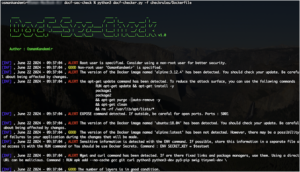Interview Spotlight: Israeli Hardware Solutions, Sepio Systems
On 19 November, E-Hacking News conducted an interesting interview with Sepio Systems. The company provides its customers with the highest level of visibility, policy enforcement, and Rogue Device Mitigation capabilities. The guest speaker for the interview was Mr. Bentsi Ben-Atar, CMO, and Co-Founder, Sepio Systems.
Founded in 2016 by veterans from the Israeli Intelligence Community, Sepio HAC-1 is the first platform that provides visibility, control, and mitigation to zero trusts, insider threat, BYOD, IT, OT, and IoT security programs. Sepio Systems is a strategic partner of Munich Re, the world’s largest reinsurance company, and Merlin Cyber, a leading cybersecurity federal solution provider.
1. Can you please introduce yourself to our readers?
Bentsi Ben-Atar: I am one of the co-founders of Sepio Systems, the company was founded by a group of founders that have been working together for almost 30 years now. We have a strong background in cybersecurity and “rogue device management” in general.
2. Can you please tell us about your company Sepio Systems?
The company deals with a very unique domain within the cybersecurity industry and that’s the issue of managing the hardware within the enterprises. What we have built is a solution that provides all the aspects related to hardware access control, we call it “HAC” and our solution is called “HAC-1.”
We see that consumers are struggling with three elements of hardware access control. The first one is the fact they have limited visibility to whatever is connected and sometimes a very significant gap between what people think is connected and to what is actually connected. So, there are visibility gaps that need to be addressed and they need to be addressed regardless of the device itself.
3. Please explain to us about Hardware Access Control.
Once you have visibility and now you are aware of your assets, then you can move to the policy enforcement features of your enterprises. It means that now you can apply certain policies while you are working from home and a different policy while you are at the office.
And once you have these two pillars in place then you can move into the more interesting part of the solution, and those are the security aspects. You know what devices are connected, you know how to disable or mitigate any risk associated with it. Now you need to provide the Rogue Device Mitigation.
4. What are Rogue Devices and what is their impact on the enterprises?
Rogue devices are devices that are either hardware manipulated or firmware manipulated devices that are introduced into the enterprises. The main channels for the attack vehicles are either the supply chain which is a significant risk for enterprises. The other popular attack vehicle is the human factor, in that case, the human beings will always be the weakest links because people can be threatened, they could be paid off, they could be extorted. I think that history along the way has shown that any human being has a weak point. If you as a cybercrime organization can extort a certain bank, gain access to a certain system, in most of the cases you will get away with that.
5. Why do you think that these “Rogue Attacks” are on the rise?
We see a growing number of attacks that are based on hardware tools. From the attacker’s perspective, they have the option of either going head to head against existing cybersecurity products, or they can find an alternative path to the enterprises. There is a lot of hardware-based attacks happening all around the world on critical infrastructures like banks, data centers, retail, etc. It doesn’t get to the public eye in most cases due to several reasons.
First, companies in most cases are very reluctant to admit the fact that they have been breached through this domain because it also implies their level of physical security and no one wants to admit that someone was able to plug in a rogue device. On the other hand, there are a lot of attacks that create signatures that may be wrongfully attributed to other types of attacks.
6. How do Sepio Systems counter these Rogue Devices?
One of the demos that we really love to do is using and demoing the vulnerability of wireless keyboards and mouse, these devices can be easily manipulated and spoofed. For example, let’s say you’re sitting in your home or office, there could be a guy sitting in the next building, it doesn’t have to be next to your endpoint. By using a very simple publicly available payload that runs on a raspberry pi, you can actually spoof the communication between that wireless keyboard and mouse. You can do a remote keylogging, and most importantly, you can point that endpoint to a certain URL that a certain piece of malware is waiting to be downloaded.
In the end, you even have to go over the human factor which is convincing the user that this link is not suspicious. So, there are a lot of obstacles that need to be dealt with. Compared with the option of coming with out of bound raspberry pi with a spoofing capability, you open up the browser independently, and forensic wise it would look like this was an act of an employee within the organization. So sometimes it would be attributed to a phishing attack or wrongful doings of an employee while in real life the story is completely different.
7. The Data Security Council of India (DSCI) has also talked about your company. Can you please tell us more about this project and ‘Sepio Prime Rogue Device Mitigation Solution?’
Our solution provides enterprises, especially the ones concerned with their data. These enterprises can be financial institutes, government agencies, or other entities extremely concerned with the attack vehicles.
We provide them with solutions that cover two main interfaces. One is the USB interface and the other is the Network interface. Our solution actually monitors and analyses the physical layer information. It means that we don’t look into user traffic, user log files. We read out all the physical layer related information by analyzing it with an algorithm which is a combination of physical layer fingerprinting and machine learning. We can actually detect the existence of such passive devices.
One of the coolest features of our solution is that it doesn’t require a baseline or training period. Obviously, in today’s cybersecurity atmosphere, no single solution provides a complete seal for the entire enterprise. Therefore, the capability of integrating other solutions is extremely important, and all these solutions are easily integrated with our solutions so that we can actually extend the visibility of the enterprise into the deeper layer.
8. Can you explain how this Layer-1 solution works?
Our solution is actually comprised of two main functionalities. The first one deals with Network Security and the second one deals with Peripheral Security/ End Point security. The way Network Security works are that we communicate with the existent networking infrastructure by using read-only commands. The only thing the enterprise needs to do is to provide restricted user credentials for our solutions.
Before our deployment, we actually provide a list of commands that we will be using. Once we get the information, we will compile it using an algorithm that is a combination of physical fingerprinting and machine learning enhanced solution. The fingerprinting is extremely important because when we get a hit, we can actually name the attacks. The deployment process itself is straight forward, it takes less than 24 hours to have everything up and running.
The output and value of this solution are instantly delivered, you can actually see all the rogue devices and visibility. In a very interesting incident, we found a gaming machine connected to a secured network, approve by NAC but never reported.
Now, the second part of this solution deals with the peripheral. It is a bit different because in the endpoint case, the endpoints could be offline, and you want to make sure that the mitigation, once a rogue device has been detected or even just a brief of policy. The mitigation needs to be immediately so that the USB device will be blocked. When the attacker comes in, they can configure their attack tools to present the same façade as a legitimate device.
So, the difference between Network Security and End Point Security (algorithm wise) is the fact that on the peripheral we also fingerprint ‘known to be good’ devices, so that we have a full database of good devices and bad devices. One of the nicest features we also have is the ‘threat intelligence database,’ which means that every installation has a local copy of our threat intelligence database which includes a list of all ‘known to be vulnerable devices.’
9. Tell us more about the leadership team behind Sepio Systems?
Our leadership is something that we take great pride in. We are a U.S-Israel based company, we are headquartered in Rockville, Maryland. We have a very strong all-women U.S board which we take great pride in, led by the current CSO for HSBC. We have interviews posted on social media which I think is a fascinating array of women that bring tremendous value to our company.
We have a strong backup from various industry leaders and veterans from various government agencies. We perceive to be kind of a task force to deal with this domain which was until now significantly underserved.
10. During the COVID-19 pandemic, everyone has started working from home, sometimes it can be a kid playing a video game on a pc. How does an organization keep the family’s data separate from the employee’s? How do you make sure that the family’s data is not being taken by your systems?
Enterprises first need to have a clear policy about their equipment. Having a policy without the capability of enforcing it is ineffective. First of all, the employee needs to understand the risks associated with it. And for that, we have a very interesting video series called Captain RDM which actually illustrates very serious cases in a non-technical way.
You can do one or two things. As a CSO, we can issue (this is what a lot of enterprises do) a company-issued device for it. If you require an additional keyboard, we will provide you with that. If this is not the case, we make sure to know that if a ‘known to be vulnerable device’ is connected and block it.
For work from home cases, we have allowed the ‘1 + 1’ option, which means that for every license that our user got they were eligible for another license without any additional costs.
11. On your website, people talked about how Sepio Systems has efficiently countered Rogue Device Threats and Internet of Threats (IoT)? Before we conclude the interview, do you have anything to say about that?
One thing that we’ve learned is never disrespecting your opponent. They will always be innovative and smart. They are able to provide attack tools that are cocooned within a legitimate-looking device in ways that you can only imagine. When there is enough motivation for the attacking party for a specific side, because its specifically lucrative target, they will find a way to get into it even if it’s a data center or a highly secured facility, anything can be achieved.
With IoT, smart nations, and smart cities coming up, a lot of hardware getting installed all over, and the Covid pandemic making people work from home, this issue becomes more relevant. It is more relevant today than it was yesterday and it is going to get even more relevant as the days go by.
If you like the site, please consider joining the telegram channel or supporting us on Patreon using the button below.




![Brute Ratel C4 Detected - 18[.]177[.]187[.]233:80 4 brute_ratel_c4](https://www.redpacketsecurity.com/wp-content/uploads/2022/07/brute_ratel_c4-300x300.jpg)
![Cobalt Strike Beacon Detected - 118[.]89[.]73[.]78:4433 5 Cobalt-Strike](https://www.redpacketsecurity.com/wp-content/uploads/2021/11/Cobalt-Strike-300x201.jpg)